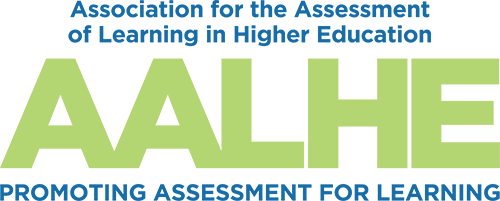- Home
- About AALHE
- Board of Directors
- Committees
- Guiding Documents
- Legal Information
- Organizational Chart
- Our Institutional Partners
- Membership Benefits
- Member Spotlight
- Contact Us
- Member Home
- Symposium
- Annual Conference
- Resources
- Publications
- Donate
EMERGING DIALOGUES IN ASSESSMENTJeff Barbee, D.M.A., M.A. As Dr. Rogers and Dr. Turbow note, finding the time to design and incorporate interprofessional experiences (IPEs) is challenging for health sciences institutions. After time is devoted to developing an assessment activity for an interprofessional experience, institutions need to consider several questions. For example, what assessment activity should be designed? How should the assessment be designed? And is it feasible and reliable? The Indiana University School of Medicine (IUSM) has begun to implement IPE into its current curriculum. The motivation for interprofessional education at the IUSM can be linked to the changes in technology and a corresponding rise in chronic diseases and the need for longitudinal team-based care. The Center for Disease Control (CDC, 2012) reports that about half of U.S. adults had one or more chronic diseases in 2012. Of the diseases listed, seven made their way in the top ten causes of death in 2014. When looking at total monetary expenditures for death in 2012, 86% was spent on chronic or mental health conditions (CDC, 2012). Treatments involved with these illnesses often require extensive interprofessional medical teamwork (Nancarrow et al., 2013). IUSM is a part of the Indiana University system. Although the flagship campus is located in Bloomington, the main home for the School of Medicine in in Indianapolis. The typical medical degree cohort is well over 300 students, much larger than the class size of most other institutions across the country. Although the school of medicine is spread over nine campuses throughout the state of Indiana, it maintains a unified goal of having one school with a common curriculum and learning experience (IUSM, 2017). The multi-campus framework presents challenges for our assessment team. The major accrediting body for IUSM is the Liaison Committee on Medical Education (LCME). LCME has12 overarching standards that its members must meet, which are also divided into multiple sub-standards. Of these standards, three specifically call for the opportunity for collaboration among students from different medical fields (Standards 6.7; 7.8; 7.9). IPEs are one component of this complex medical curriculum. It is challenging to provide a thorough and comprehensive medical education which meets all expectations in a working- world defined by limited timelines and competing interests. At IUSM, we have the Center for Interprofessional Health Education and Practice. The mission of our center is to prepare future healthcare professionals to be effective team members as they begin their careers. The center provides students with opportunities to collaborate with others from different health profession backgrounds, provide tools to complete interprofessional education as part of the learning experience, and links to webinars and information about funding opportunities (Center of Interprofessional Practice and Education, 2017). A unique opportunity at the Indiana University School of Medicine was receiving the American Medical Association (AMA) Accelerating Change in Medical Education (ACE) program grant. The grant was designed to help develop new curricula and teaching modalities in medical education. The course IUSM proposed was added to the curriculum for third-year medical students, and offered as an opportunity for students from other health professions. The long-term goal was to make this a part of multiple health science programs curriculum to enjoy a robust and life-like simulation opportunities. Johnson and Freeman (2014) found that students who participate in these types of activities gain a better understanding of their own professional identity while also learning more about the roles of other healthcare professionals. IUSM worked with the Regenstrief Institute to develop a tEMR (teaching Electronic Medical Record). The tEMR is a database of de-identified actual patient data that create a realistic virtual health care system that students can use for assignments and projects. Medical students were assigned one patient from the tEMR with multiple chronic issues to help them understand different issues related to care of such patients at different times throughout their care. Students from the fields of pharmacy, nursing, and social work served as consultants for medical students seeking advice and guidance with their assigned projects. This allowed for students to better understand longitudinal care, as well as gain an understanding of roles from other health professions. Challenges presented with the AMA grant include the class size of medical students compared to the limited number of students from other fields who agreed to participate and the easy temptation to overload the students who are volunteering their time for this experience. The assessment instrument for the inaugural class was a peer evaluation of the members of their group. Having students evaluate their group peers required us to devote many hours to building the instrument, then collecting and analyzing data which offered little information at the conclusion of the process. Students gave each other passing or high passing marks with few exceptions. These evaluations were also limited in scope of a medical student evaluating another medical student within their group. The groups were comprised of twelve students with undefined roles, so measuring the effectiveness of IPE experiences was difficult. In many respects this is understandable because finding reliable assessment instruments for IPE is difficult in general. Lutifyya, Brandy, and Cerra (2016) explain research is needed for many of the instruments that have been designed. Current studies have not been successfully replicated and need larger sample sizes to test reliability. Another challenge is the tEMR itself. Students serving in the consulting roles may have not had experience working with an EMR, or had the time to learn it effectively. While challenging, this presents opportunities to allow different health professional students to navigate an EMR that they will have to use in a clinical setting. To refine our IPE efforts at IUSM this year, our team redesigned the groups to be smaller with precisely defined roles for the students to fulfill. Pharmacy students are also now included in these groups and rotate to a new group for each session and serve in a consultative role on the case. Our goal is to gather better data from the adjustments that we have made. We intend to compare how medical students evaluate one another compared to how pharmacy students evaluate them. Nancarrow et al. (2013) cites that it is common for large teams of interprofessionals to have challenges of working together due to multiple perspectives and possible challenges to traditional hierarchical structures. We are intentionally looking at these challenges by examining how students evaluate IPEs within a group. This is an area of interest we will be looking into by having students evaluate the effectiveness of their group. For future implementation, IUSM is adding an IPE component into the Objective Structured Clinical Examination (OSCE). The OSCE takes place in simulated medical settings where a student interacts with an actor who portrays a scripted patient, known as a standardized patient (SP). The idea is to also have a simulated medical inter-professional (e.g., pharmacist) interact with the student in order to better simulating the clinical experience. The challenges of testing these skills through an OSCE have both logistical and financial challenges. Johnson and Freeman (2014) list that funding, areas of focus, values, and points of view are common obstacles when preparing to implement an interprofessional education experience. As Dr. Rogers and Dr. Turbow pointed out, the effective design of appropriate assessments for interprofessional education begins by intentionally considering our learning objectives. The teams who are tasked with developing IPE competencies for specific alignment with accreditation standards must thoroughly consider the rigorous demands of the student clinical experience. Perhaps there are other fields we can look to as a model, or perhaps interprofessional education begins with assessment specialist and medical education faculty? Dr. Barbee is an Assessment and Evaluation Specialist at the Indiana University School of Medicine. His duties include developing and assisting with assessments of the Phase 1 curriculum, developing and analyzing peer evaluations for the Health System Science course, and helping administer the OSCE exams. References Centers for Disease Control and Prevention. (2012). Chronic Disease Overview. U.S. Department of Health and Human Services, Atlanta. Retrieved from: https://www.cdc.gov/chronicdisease/about/index.htm Center of Interprofessional Practice and Education. (2017). Indiana University. Indianapolis IN. Retrieved from: https://ipe.iu.edu Indiana University. (2017). School of Medicine. Indianapolis, IN. Retrieved from: https://medicine.iu.edu/ Johnson, K., & Freeman, K. (2014). Integrating interprofessional education and collaboration competencies (IPEC) into mental health counselor education. Journal of Mental Health Counseling, 36(4), 328-344. Lutfiyya, M., Brandt, B., & Cerra, F. (2016). Reflections from the intersection of health professions education and clinical practice: The state of the science of interprofessional education and collaborative practice. Academic Medicine, 91(6), 766-771. Nancarrow, S., Booth, A., Ariss, S., Smith, T., Enderby, P., & Roots, A. (2013). Ten principles of good interdisciplinary team work. Human Resources for Health, 11(19), 1-11. |

